Are you tired & bored of plain concrete surfaces in your outdoor spaces? If so, Let’s discover the beauty and versatility of stamped concrete!
What is stamped concrete?
Stamped concrete is nothing but conventional concrete that is designed or imprinted to resemble the look of other materials such as brick, flagstone, slate, wood, etc.
It offers a versatile way to create unique patterns and designs of our choice. The pattern or design is created by pressing a rubber or metal stamp onto the surface of the wet concrete before it hardens.
It is used to decorate the patio floors, pool decks, driveways, courtyard, sidewalk, etc. It is an affordable way to make your outdoor space look premium without any high price tag.
It is also known as stamped concrete (or) Imprinted concrete (or) Textured concrete.
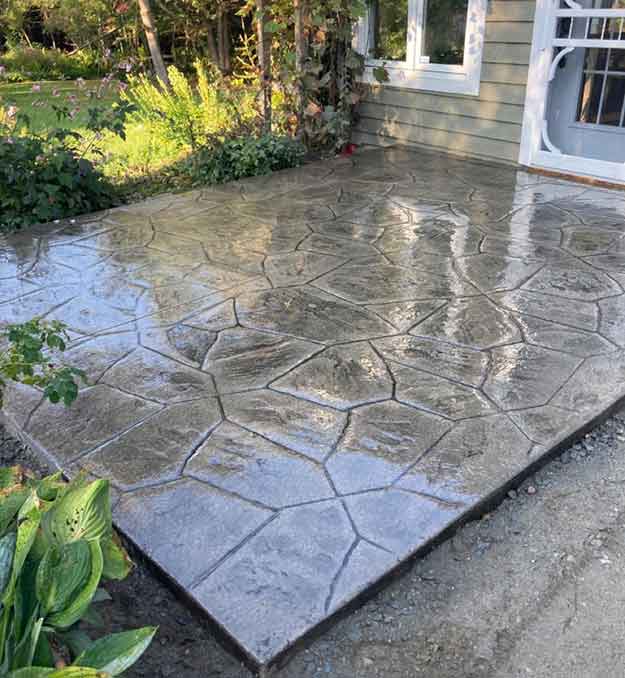
How to make stamped concrete?
The various processes involved in the production of stamped concrete are discussed below.
Step 1: Site preparation
The first step is to prepare the site for laying concrete. This involves,
- Compacting the base with the rammer increases the strength of the base soil and also eliminates the settlement of soil after laying concrete.
- Make sure that the concrete laying area is clear of any vegetation and impurities.
- Make sure to install drainage systems, if any.
Step 2: Placing formwork and steel reinforcement
Place the formwork on the prepared base according to the required dimension and make sure that the formwork is fixed properly so that it does not slip off during concrete pouring.
Now place the steel reinforcement mesh with an adequate cover from the soil. The main purpose of providing steel reinforcement mesh is to distribute the load, control cracking, and increase the strength and durability of the concrete.
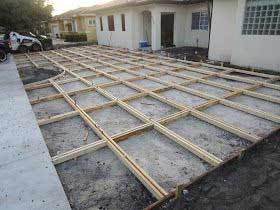
Step 3: Pouring concrete
Before pouring concrete, make sure that all the works listed above are executed perfectly.
Once the site is ready, concrete of suitable grade is poured, compacted, and leveled to the desired thickness. It is recommended to use ready-mix concrete instead of hand-mixed concrete for better quality.

Step 4: Adding color hardener
Once the concrete is leveled, color hardeners are applied on the surface of the wet concrete before stamping.
It is in powder form and thrown by hand onto the surface of the wet concrete. Once it is absorbed by the concrete, the surface is troweled or floated to create a uniform surface.
The main purpose of applying color hardener is to create an attractive color for the concrete surface and also to make it more durable and long-lasting.

Step 5: Apply release agents
Once the concrete is sufficiently floated, a release agent is applied to the surface of the concrete.
The main purpose of the release agent is to prevent the stamping tools from sticking to the concrete surface. It creates a barrier between the stamping tool and the concrete surface, allowing us to create a clean impression.
Once the stamping process is finished and the concrete is sufficiently set, we can wash off these release agents.
Step 6: Stamping the concrete
After applying the release powder, check the plasticity of the concrete.
If the concrete is too wet, the stamped impression may distort and if the concrete is too hard, the stamping process has become much more difficult and it is a lot harder to get the pattern imprinted.
Now, place the desired stamp pattern and pound the top of the stamp to get the pattern imprinted onto the concrete surface.
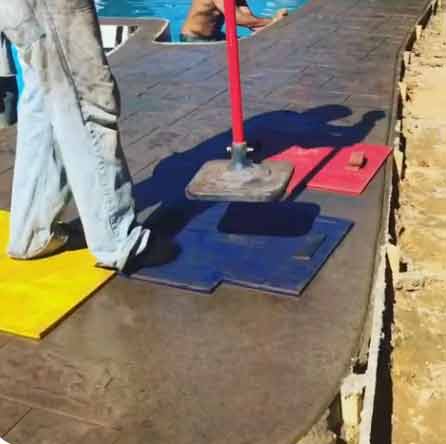
Step 7: Clean the stamped surface
Once the stamping process is done, the releasing agents are washed from the surface of the concrete using a pressure washer.
Step 8: Provide joints
Once the concrete is stamped, control joints are usually cut into the surface of the concrete to control cracking and shrinkage.
Typically, joints in stamped concrete are provided after the concrete has been stamped. But if the joints are not causing any disturbance to the stamping process, then it may be provided before the stamping process.
Step 9: Finishing the concrete
After completing all the steps listed above, concrete is allowed to cure for the recommended amount of duration. The curing can be done by spraying water or curing compounds.
Once the concrete is sufficiently cured, it is cleaned and a seal coat is applied to preserve and enhance its appearance and durability.
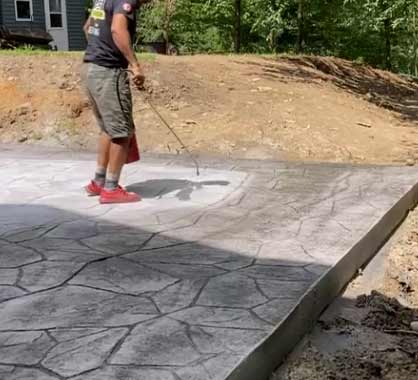
It is important to note that the process described here is a standard one. It can change depending on the requirements of the project.
Now, we know about the process of making stamped concrete. Let’s discuss the various designs and patterns that are available to make stamped concrete.
Patterns for stamped concrete
Some of the popular patterns of stamped concrete are listed below.
1) Stone patterns for stamped concrete
Stone is a natural captivating material with inherent beauty. It carries a timeless aesthetic appeal and has been the standard building material for millennia.
Stamped concrete allows us to harness the beauty of natural stone without a high price tag. Some of the major stone patterns that are widely used are discussed below.
a) Ashlar stone pattern
It is a popular choice for stamped concrete. This pattern features larger stones covered by smaller ones and is suitable for driveways, patios, or walkways.

b) Random stone pattern
This pattern features various stone shapes and sizes arranged in a non-uniform manner to imitate natural randomness.
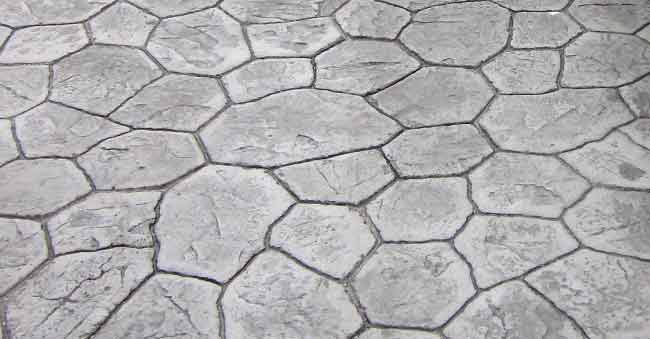
c) Cobblestone pattern
This pattern imitates the look of traditional cobblestone streets. It consists of small, rounded shaped stones arranged in a grid-like pattern. This pattern can even improve the traction of the concrete surface by reducing the risk of slips.

d) Flagstone pattern
This pattern features irregularly shaped stones packed closely together to resemble the look of real flagstone. It provides a natural aesthetic for outdoor spaces.
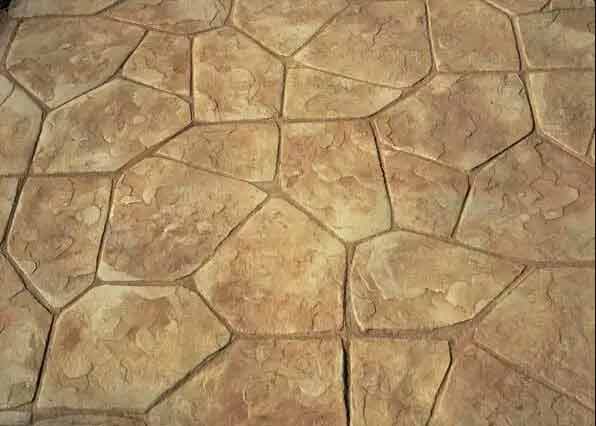
2) Slate patterns for stamped concrete
These patterns bring the natural beauty and elegance of real slate to your outdoor spaces. Some of the major patterns are listed below.
a) Ashlar slate stamped concrete
This pattern replicates the appearance of regularly shaped slate stones laid in a random pattern. It is one of the popular choices for outdoor spaces like patios, pool decks, etc.
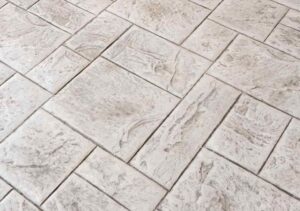
b) Roman slate stamped concrete
It is specifically designed to replicate the look of an ancient Roman slate. It consists of Symmetrical patterns that resemble the hand-laid stones in a grid formation.
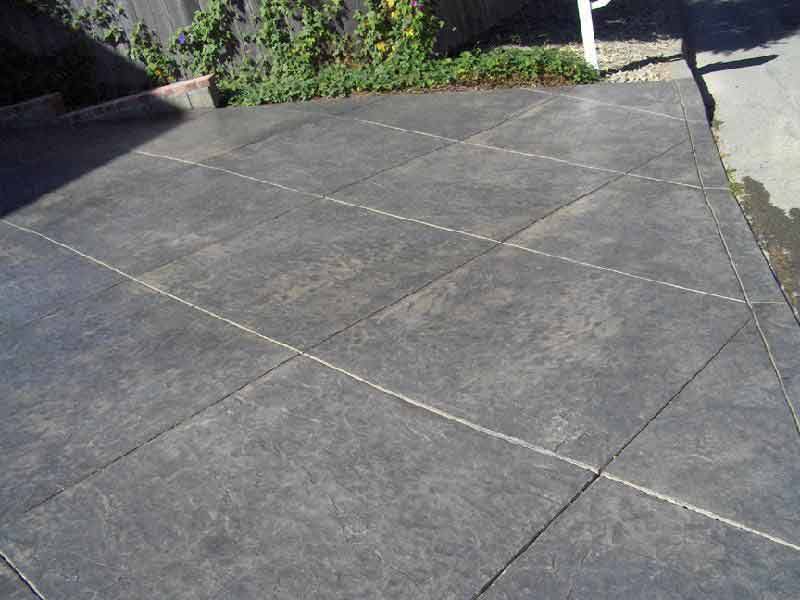
c) Herringbone slate stamped concrete
This pattern features a rectangular tile placed at 45 degrees to create a zig-zag pattern. This pattern offers a timeless aesthetic look for your outdoor spaces.
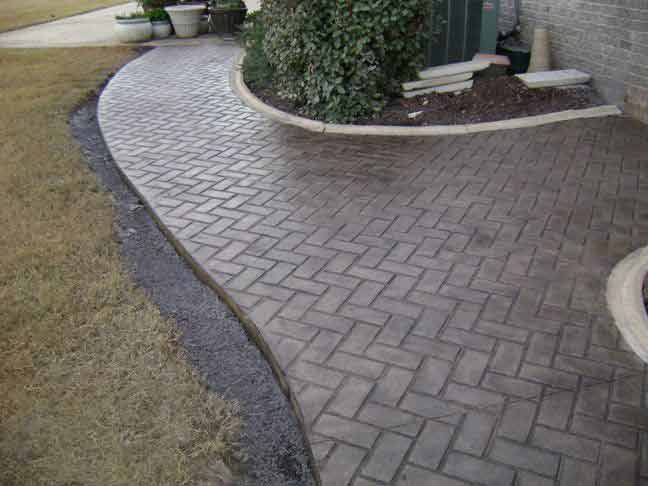
3) Wood patterns for stamped concrete
Wood patterns for stamped concrete have become popular over recent years. It can replicate the texture and shape of several kinds of wood. Some of the major patterns are listed below.
a) Wood plank pattern
This pattern mimics the appearance of long, narrow wooden planks along with its realistic features like wooden grains, knots, etc.
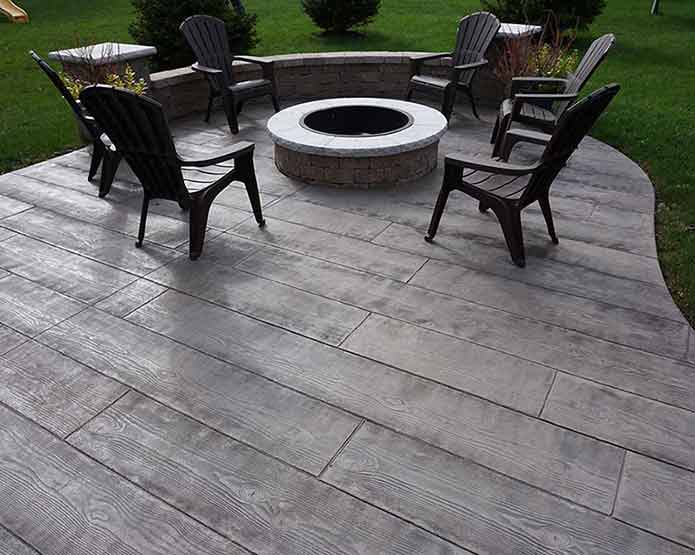
b) Weathered wood pattern
This pattern can be able to recreate the pattern of aged and weathered wood along with features like cracks, worn-out textures, etc.
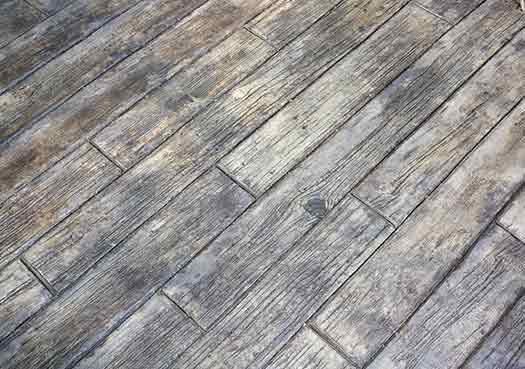
c) Boardwalk wood pattern
This pattern mimics the appearance of wood that is commonly used in coastal boardwalks. This pattern can create a seaside atmosphere in your outdoor spaces.

4) Brick & Tile patterns for stamped concrete
a) Running bond brick pattern
This pattern replicates the traditional bricklaying technique commonly used in brick masonry. It creates an arrangement of rectangular bricks with each row offset by a half brick length.

b) Herringbone brick pattern
This pattern creates an arrangement of rectangular bricks at 45 degrees to create a V-shaped pattern and to form interlocking patterns.

c) Basket weave brick pattern
This pattern involves arranging rectangular bricks in pairs, with each pair placed perpendicular to the adjacent pairs. The result is a visually striking design that resembles the weaving pattern of a basket.
Due to its unique design, it becomes a popular choice for patios, walkways, and other outdoor spaces.

Remember these are some of the popular patterns that have been widely used in the market. But other than this, there are plenty of designs and patterns available & used all over the world.
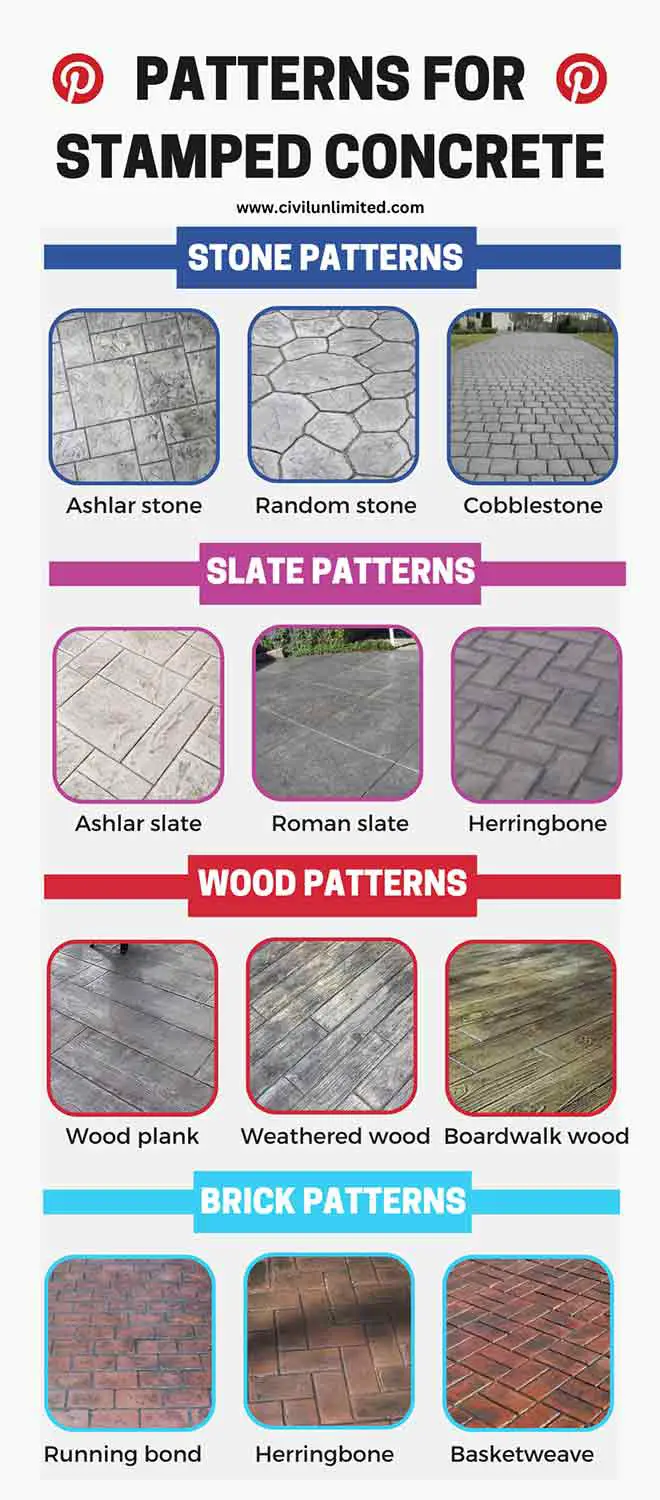
Advantages of stamped concrete
1) Versatility – It offers more design options and customizations including various patterns, textures, etc.
2) Cost-effective – It can mimic the look of any natural materials such as stone, wood, brick, etc. Stamped concrete can be a cost-effective alternative for all high-end aesthetic materials.
3) High durability – When properly constructed, stamped concrete is highly durable and can withstand heavy pedestrian and vehicular traffic.
4) Low maintenance – Stamped concrete requires relatively low maintenance compared to any other high-end materials. It can be easily cleaned with regular sweeping and once in a time required power washing.
5) Slip resistance – Stamped concrete patterns offer various surface textures, some of which can improve traction and reduce the chance of slip or fall. This makes it a safer option for areas such as pool decks, walkways, driveways, etc.
Disadvantages of stamped concrete
1) Limited repairs – If any damage occurs to the stamped concrete, it isn’t easy to match the color and pattern of the newly laid concrete with the old one.
2) Initial installation cost – While stamped concrete can be more cost-effective than natural stone, the installation cost can be still higher than the standard concrete. Additionally, the cost can be increased according to the complexity of the project.
3) Resealing & Maintainance – Stamped concrete requires periodic resealing to protect it from environmental agents. Depending on the climate and usage, resealing may need to be done every few years.
4) Heat retention – In hot climates, stamped concrete can retain some heat hence it becomes hard to walk on it in bare heat. Lighter color may reduce heat absorption.
5) Can’t DIY – Do It Yourself is not recommended for the stamped concrete project as it requires special tools and a certain level of expertise.
How much does stamped concrete cost?
The cost of stamped concrete can vary depending on the region, materials used, the complexity of the project, the labor involved, etc.
In general, it can cost around 15 to 20 dollars per square foot.
However, if your project has more than one pattern (or) has to add multiple colors (or) has to lay extra thickness of concrete for the driveway, then your cost may increase above the average price range.
It’s advisable to consult with local concrete contractors or professionals for more accurate cost estimates based on your specific project requirements and location.
Hope this article provides you with more information about the stamped concrete. If you find this article helpful, let us know in the comment section.
Read more:
A Detailed Guide to Brick Wall Cracks & How to repair them
25 Necessary Guidelines For Constructing A Good Quality Brick Masonry
How to check the quality of cement at the construction site?

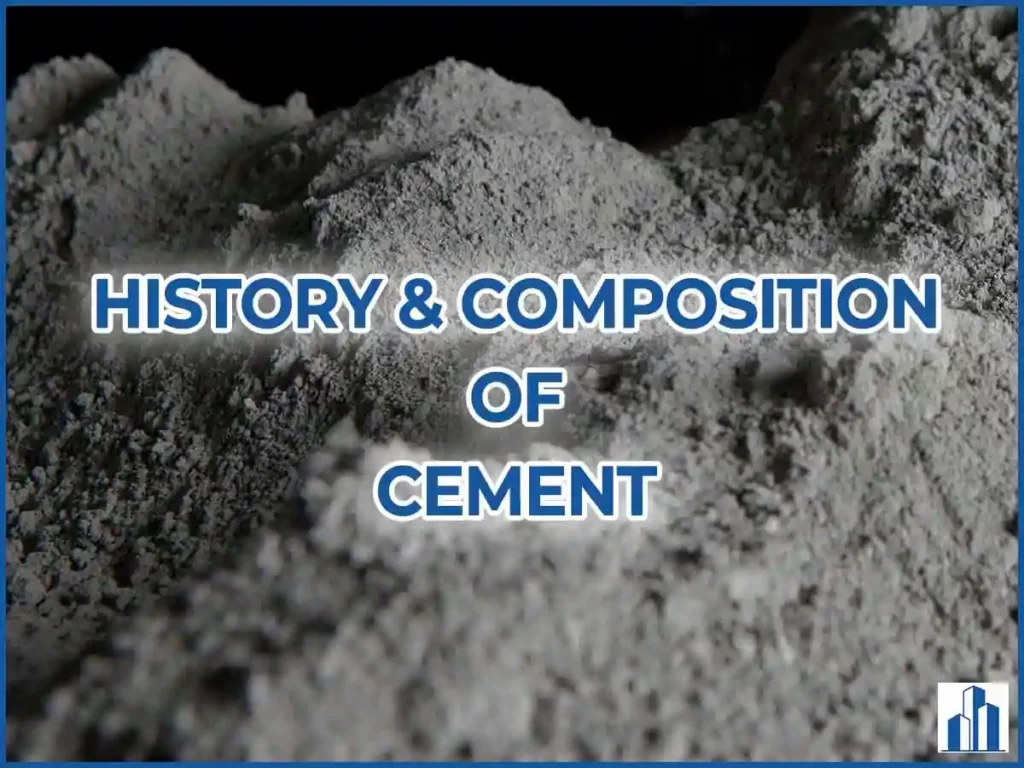
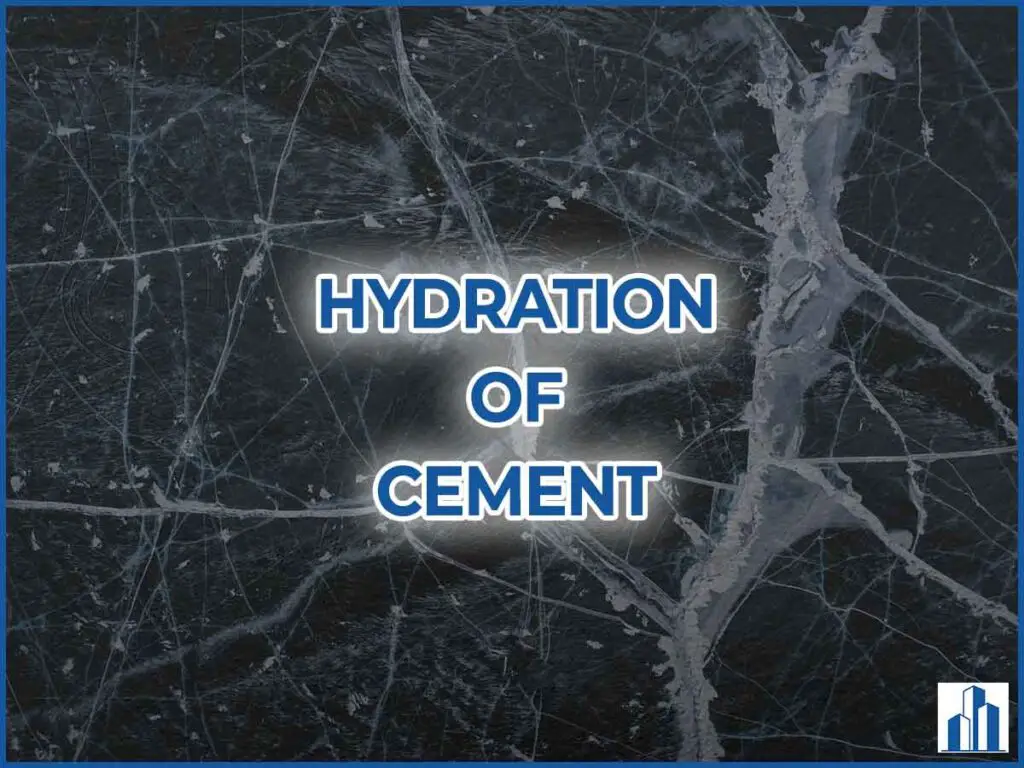

Pingback: Spalling Of Concrete: Causes, Effects, And Prevention | Civilunlimited.com
Denali Construction is a renowned company that excels in providing exceptional services such as Decorative concrete overlay, stone work, and decorative concrete in the Albany, Saratoga, and Clifton Park areas of New York, along with the neighboring regions. When it comes to top-notch stamped concrete, vertical stamping, and reliable concrete contractors in Albany, Denali Construction is the name to trust. Contact us today for unparalleled services.